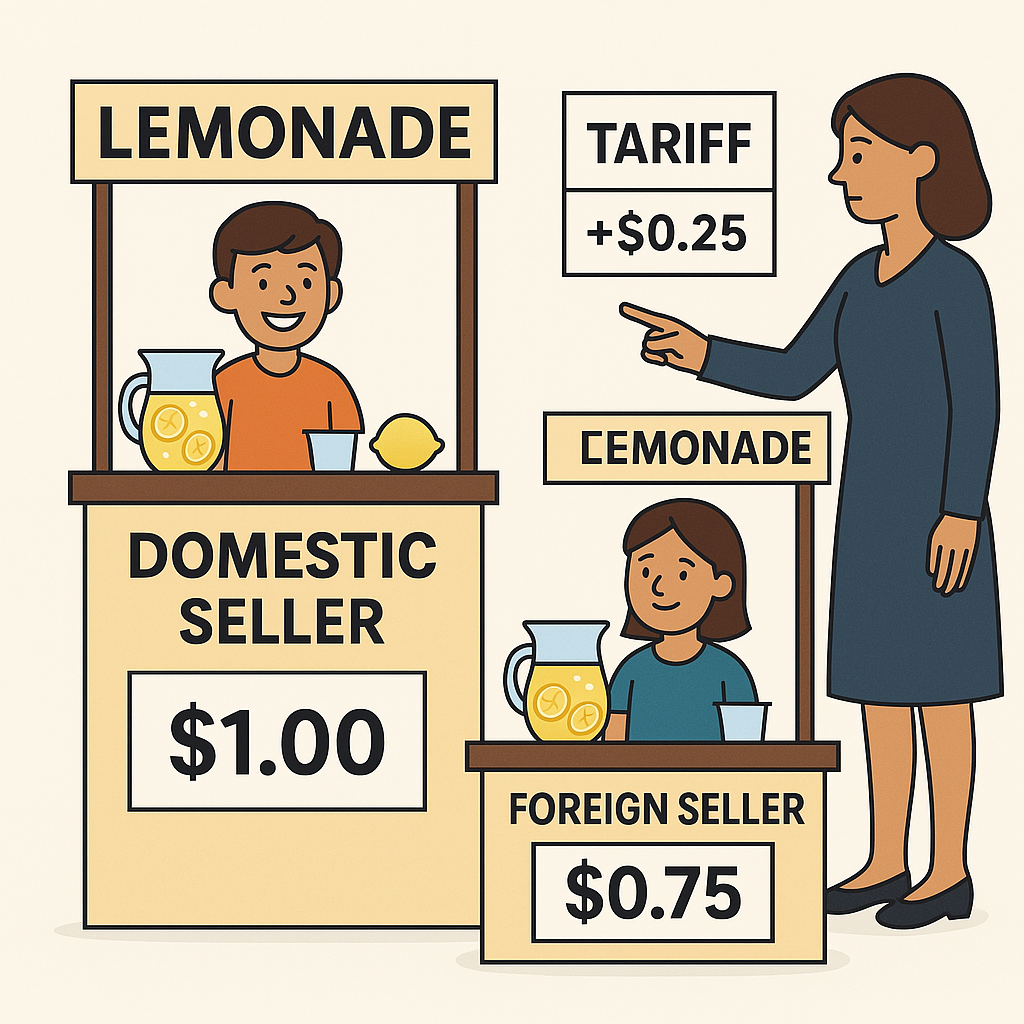At Persuadius, we specialize in transforming complexity into clarity—especially using litigation graphics. Whether it’s a demonstrative exhibit that makes a technical expert accessible or a timeline that crystallizes causation, the right visual can make all the difference.
Economic issues like tariffs and trade deficits frequently show up in high-stakes commercial litigation. But jurors aren’t economists. That’s where compelling storytelling—and litigation graphics—come in.
What Is a Tariff?
A tariff is a tax placed on imported goods. When a country imports products from abroad—say, steel, cars, or electronics—the government can charge a fee at the border. That fee is the tariff.
Why do governments use tariffs?
• To protect domestic industries by making foreign goods more expensive.
• To generate revenue (especially in developing economies).
• To pressure trading partners during disputes.
The Lemonade Stand Analogy & Litigation Graphic
To make the idea real, let’s take it to the neighborhood level:
Imagine your child runs a lemonade stand, selling cups for $1. A neighbor’s child sets up a competing stand across the street and offers lemonade for 75 cents. Naturally, customers head over there.
You, acting as the “government,” impose a 25-cent tariff on each cup sold by the neighbor. That makes their price $1—just like your child’s. Suddenly, it’s an even playing field again.
The tariff didn’t ban competition. It just made the imported lemonade less competitive by adding a cost.
A trial attorney might use a version of the litigation graphic shown here to tell the tariff story. This kind of visual isn’t just helpful for a blog—it’s exactly the kind of litigation graphic that resonates with jurors. Simple. Concrete. Memorable.
What Is a Trade Deficit?
A trade deficit happens when a country imports more than it exports—that is, when it buys more from other countries than it sells to them. It’s essentially a financial imbalance in international trade.
To use our analogy again:
If your family keeps buying lemonade from other neighborhood stands, but no one buys your lemonade in return, your household has a lemonade trade deficit.
In the U.S., trade deficits are often part of the political conversation around tariffs. Some argue that tariffs help reduce trade deficits by discouraging imports. Others point out that tariffs can trigger retaliation, hurting U.S. exports and making the deficit worse.
The Role of Litigation Graphics in Explaining Economic Concepts
This is where trial visuals shine. When presenting concepts like tariffs or trade deficits to a jury, litigation graphics can anchor your narrative and elevate your credibility. Here’s how they help:
• Clarify cause-and-effect (e.g., how a tariff raises prices)
• Depict global relationships (e.g., trade imbalances)
• Simplify timelines or policy shifts
• Reinforce your case themes visually
Whether you’re litigating a cross-border supply chain dispute or defending a pricing model affected by trade policy, visuals that explain the “why” behind your numbers are essential.
Why Tariffs (and Trade Deficits) Matter in Litigation
These concepts often show up in high-stakes litigation:
• Patent or IP cases involving imported goods
• Contract disputes involving international suppliers
• Antitrust or unfair trade practice claims
• Government investigations or sanctions enforcement
Jurors may be asked to consider how tariffs affected pricing, availability, or business decisions. But jurors aren’t economists. They need clean, common-sense explanations backed by credible visuals and strong storytelling.
How to Explain This to a Jury
When a concept is this complex, clarity isn’t optional—it’s strategic. Here’s how we help trial teams bring it home:
• Use visual analogies (like the lemonade stand) that feel familiar
• Avoid jargon—skip “macroeconomic policy lever” in favor of “a tax at the border”
• Frame the impact in terms of fairness, competition, and cause-and-effect
• Use graphics that show pricing changes or flows of goods in a way anyone can grasp
Takeaway
Tariffs and trade deficits may seem like the stuff of cable news and policy panels, but they show up in courtrooms more than you’d expect. And whether you’re persuading a jury or explaining global trade over spaghetti, matzah, or lamb, the same principles apply: simplify, illustrate, and connect to what people already understand.
At Persuadius, we don’t just clarify complexity—we make it compelling.






Leave a Comment